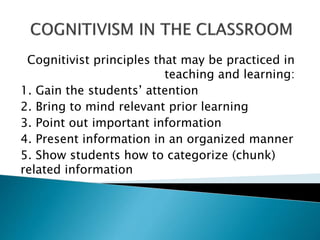
Cognitivism in the classroom (1)
- 1. Cognitivist principles that may be practiced in teaching and learning: 1. Gain the students’ attention 2. Bring to mind relevant prior learning 3. Point out important information 4. Present information in an organized manner 5. Show students how to categorize (chunk) related information
- 2. 6. Provide opportunities for students to elaborate on new information 7. Show students how to use coding when memorizing lists 8. Provide for repetition for learning
- 3. Concerned with how learners can develop their human potential. (Maslow, Rogers) Some humanistic techniques in the classroom: 1. Establish a warm , democratic, positive and non-threatening learning environment in which learner’s self-concept and self-esteem are considered essential factors in learning. 2. When it seems appropriate, function as a facilitator where you work and share ideas with students.
- 4. 3. When the teacher is comfortable, he may occasionally show his/her “real person” by telling students how he/she feels. 4. Provide learning experiences that will lead to the development of habits and attitudes that teachers want to foster. 5. Teachers should be role models and should set good examples.
- 5. 6. Students and teachers plan together the experiences and activities of the curriculum. 7. Students are given choices (with limitations) and freedom (with responsibilities); the extent of choices and freedom is related to the maturity level and age of students. 8. Learning is based on life experiences, discovery, exploring and experimenting.
- 6. * PSYCHOLOGISTS ARE CONCERNED WITH HOW LEARNERS CAN DEVELOP THEIR HUMAN POTENTIAL; THE PROCESS NOT THE PRODUCTS, PERSONAL NEEDS NOT THE SUBJECT MATTER, PSYCHOLOGICAL MEANING AND ENVIRONMENTAL SITUATIONS. * THE PSYCHOLOGICAL FOUNDATIONS WILL HELP CURRICULUM MAKERS IN NURTURING A MORE ADVANCED, MORE COMPREHENSIVE AND COMPLETE HUMAN LEARNING.
- 7. Society as ever dynamic is a source of very fast changes which are difficult to cope with and adjust to. Thus, schools are made to help to understand these changes. In order for schools to be relevant, schools’ curricula should address diversity, explosion of knowledge, school reforms and education for all. To be relevant, the curricula should reflect and preserve the culture of society and its aspirations. At the same time, society should also imbibe the changes brought about by the formal institutions called schools.
- 8. 1. Curriculum as a Content or a Body of Knowledge 2. Curriculum as a Process 3. Curriculum as a Product
- 9. 1. Significance 2. Validity 3. Utility 4. Learnability 5. Feasibility 6. Interest
- 10. 1. Balance – fairly distributed in depth and breadth 2. Articulation – smooth connections or bridging should be provided 3. Sequence – logical arrangement of the content 4. Integration – Content in the curriculum does not stand alone or in isolation 5. Continuity – it should continuously flow as it was before, to where it is now, and where it will be in the future 6. Scope – breadth and depth of the curriculum
- 11. 1. Curriculum Planning – consider philosophy, vision, mission, goals 2. Curriculum Designing – how curriculum is conceptualized – selection and organization of content, learning experiences, assessment procedure 3. Curriculum Implementing – putting into action the plan 4. Curriculum Evaluating – determining the extent to which the desired outcomes have been achieved
- 12. 1. Ralph Tyler Model: Four Basic Principles a. What education purposes should schools seek to attain? b. What educational experiences can be provided that are likely to attain these purposes? c. How can these educational experiences be effectively organized? d. How can we determine whether these purposes are being attained or not? (evaluation)
- 14. Curriculum Development consists of four steps: a. Goals, objectives and domains (personal development, human relations, continued learning skills, specialization) b. Curriculum designing – based on students’ needs and interests c. Curriculum implementation – preparation of instructional plans d. Evaluation – use of a variety of evaluation techniques
- 15. 1. Curriculum change is inevitable, necessary and desirable. 2. Curriculum is a product of it’s time. 3. Curriculum changes made earlier can exist concurrently with newer curriculum changes 4. Curriculum change depends on people who will implement the change 5. Curriculum development is a cooperative group activity 6. Curriculum development is a decision-making process made from choices of alternatives
- 16. 7. Curriculum development is an ongoing process 8. Curriculum development is more effective if it is a comprehensive process, rather than a “piecemeal”. 9. Curriculum development is more effective when it follows a systematic process 10. Curriculum development starts from where the curriculum is.
- 17. 1. Intended learning outcomes (ILO) or the Desired Learning Outcomes (DLO) 2. Subject Matter or Content 3. Teaching and Learning Methods 4. Assessment evaluation
- 18. Begin with the end in view Expressed in action words (Bloom, Andersen, Krathwol, Simpson) SMART II. Content/Subject Matter Relevant to outcomes Appropriate to development levels of learners Up-to-date Follow BASICS References
- 19. Research on the following: a. Direct Instruction: Barak Rosenshine Model b. Guided Instruction: Madeline Hunter Model c. Mastery Learning: JH Block and Lorin Anderson Model d. Systematic Instruction: Thomas Good and Jere Brophy Model
- 20. Criteria : a. Adequacy – actual learning space or classrooms b. Suitability – refers to planned activities c. Efficiency – refers to operational and instructional effectiveness d. Economy – refers to cost effectiveness
- 21. Forms of Assessment: a. Self-assessment – students learn to monitor and evaluate their own learning. b. Peer assessment – students provide feedback on each other’s learning c. Teacher assessment – teacher prepares and administers tests and gives feedback Assessment may be formative or summative
- 22. Formative – providing feedback to help the student learn more Summative – expressing a judgment by reference to stated criteria